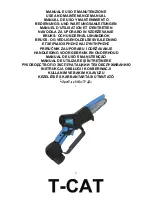
8
6. Testing
The cut-off saw should be tested before and after servicing – before servicing to
check if there are certain problems related to the saw, and after servicing to ensure
that the saw works satisfactorily. Efficient testing can only be done by means of test
equipment that includes a flow and pressure gauge.
The cut-off saw only works satisfactorily if the return pressure of the power source is
not too high - therefore check this prior to testing the saw. Mount the test equipment
at the end of the extension hose without the saw connected. If the test equipment
has a flow valve, it must be fully open during the entire test. Set the power source
on “ON”, and check that the oil flow corresponds to the technical data of the cut-off
saw. At this time the pressure may not exceed 40 bar.
Test the cut-off saw by mounting the test equipment at the pressure hose just
before the saw. If the test equipment has a flow valve, it must be fully open during
the entire test. Set the power source on “ON” and activate the cut-off saw. Measure
oil flow and working pressure when the saw has warmed up. The oil flow must
correspond to the technical data of the saw, and at this oil flow the working pressure
of the saw must be in accordance with the technical data. A deviation of up to 15 bar
is, however, within normal.
The above measurements and a visual control will ensure a fully functional cut-off
saw.
Working Pressure
14” Cut-Off Saw
Free Air
(without cutting)
Cutting
20 l.p.m.
75-85 bar
120–150 bar
30 l.p.m.
85-95 bar
130-155 bar
Working Pressure
16” Cut-Off Saw
Free Air
(without cutting)
Cutting
20 l.p.m.
55-65 bar
90-150 bar
30 l.p.m.
75-85 bar
100-150 bar
40 l.p.m.
95-105 bar
125-160 bar
Working Pressure
18” Cut-Off Saw
Free Air
(without cutting)
Cutting
20 l.p.m.
55-65 bar
90-150 bar
30 l.p.m.
75-85 bar
100-150 bar










































